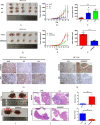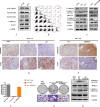Stage IV colon cancer patients without DENND2D expression benefit more from neoadjuvant chemotherapy
- PMID: 35523764
- PMCID: PMC9076603
- DOI: 10.1038/s41419-022-04885-8
Stage IV colon cancer patients without DENND2D expression benefit more from neoadjuvant chemotherapy
Abstract
According to the EPOC study, chemotherapy could improve 5-year disease-free survival of stage IV colon cancer patients by 8.1%. However, more molecular biomarkers are required to identify patients who need neoadjuvant chemotherapy. DENND2D expression was evaluated by immunohistochemistry in 181 stage IV colon cancer patients. The prognosis was better for patients with DENND2D expression than patients without DENND2D expression (5-year overall survival [OS]: 42% vs. 12%, p = 0.038; 5-year disease-free survival: 20% vs. 10%, p = 0.001). Subgroup analysis of the DENND2D-negative group showed that patients treated with neoadjuvant chemotherapy achieved longer OS than patients without neoadjuvant chemotherapy (RR = 0.179; 95% CI = 0.054-0.598; p = 0.003). DENND2D suppressed CRC proliferation in vitro and in vivo. Downregulation of DENND2D also promoted metastasis to distant organs in vivo. Mechanistically, DENND2D suppressed the MAPK pathway in CRC. Colon cancer patients who were DENND2D negative always showed a worse prognosis and were more likely to benefit from neoadjuvant chemotherapy. DENND2D may be a new prognostic factor and a predictor of the need for neoadjuvant chemotherapy in stage IV colon cancer.
© 2022. The Author(s).
Conflict of interest statement
The authors declare no competing interests.
Figures





Similar articles
-
Effect of Comorbidities in Stage II/III Colorectal Cancer Patients Treated With Surgery and Neoadjuvant/Adjuvant Chemotherapy: A Single-Center, Observational Study.Clin Colorectal Cancer. 2018 Sep;17(3):e489-e498. doi: 10.1016/j.clcc.2018.03.010. Epub 2018 Mar 21. Clin Colorectal Cancer. 2018. PMID: 29650416
-
Controversial Issues Regarding Obligatory Adjuvant Chemotherapy for Stage IIIA Colon Cancer.Clin Colorectal Cancer. 2020 Dec;19(4):e157-e163. doi: 10.1016/j.clcc.2020.03.001. Epub 2020 Mar 19. Clin Colorectal Cancer. 2020. PMID: 32896486
-
ERCC1, defective mismatch repair status as predictive biomarkers of survival for stage III colon cancer patients receiving oxaliplatin-based adjuvant chemotherapy.Br J Cancer. 2013 Apr 2;108(6):1238-44. doi: 10.1038/bjc.2013.83. Epub 2013 Mar 12. Br J Cancer. 2013. PMID: 23481186 Free PMC article.
-
Correlation of pathologic complete response with survival after neoadjuvant chemotherapy in bladder cancer treated with cystectomy: a meta-analysis.Eur Urol. 2014 Feb;65(2):350-7. doi: 10.1016/j.eururo.2013.06.049. Epub 2013 Jul 3. Eur Urol. 2014. PMID: 23849998 Review.
-
Interventions and Outcomes for Neoadjuvant Treatment of T4 Colon Cancer: A Scoping Review.Curr Oncol. 2021 May 29;28(3):2065-2078. doi: 10.3390/curroncol28030191. Curr Oncol. 2021. PMID: 34072615 Free PMC article.
Cited by
-
CircDENND2D Inhibits PD-L1-Mediated Non-Small Cell Lung Cancer Metastasis and Immune Escape by Regulating miR-130b-3p/STK11 Axis.Biochem Genet. 2023 Dec;61(6):2691-2709. doi: 10.1007/s10528-023-10401-0. Epub 2023 May 24. Biochem Genet. 2023. PMID: 37222962
-
Development of macrophage-associated genes prognostic signature predicts clinical outcome and immune infiltration for sepsis.Sci Rep. 2024 Jan 23;14(1):2026. doi: 10.1038/s41598-024-51536-3. Sci Rep. 2024. PMID: 38263335 Free PMC article.
-
Analysis of Prospective Genetic Indicators for Prenatal Exposure to Arsenic in Newborn Cord Blood of Using Machine Learning.Biol Trace Elem Res. 2024 Jun;202(6):2466-2473. doi: 10.1007/s12011-023-03863-1. Epub 2023 Sep 23. Biol Trace Elem Res. 2024. PMID: 37740142
References
-
- Sobon L, Wittekind C. UICC TNM classification of malignant tumors. New York: Wiley; 2002.
-
- Foster JH. Treatment of metastatic disease of the liver: a skeptic's view. Semin Liver Dis. 1984;4:170–9. - PubMed
Publication types
MeSH terms
LinkOut - more resources
Full Text Sources

